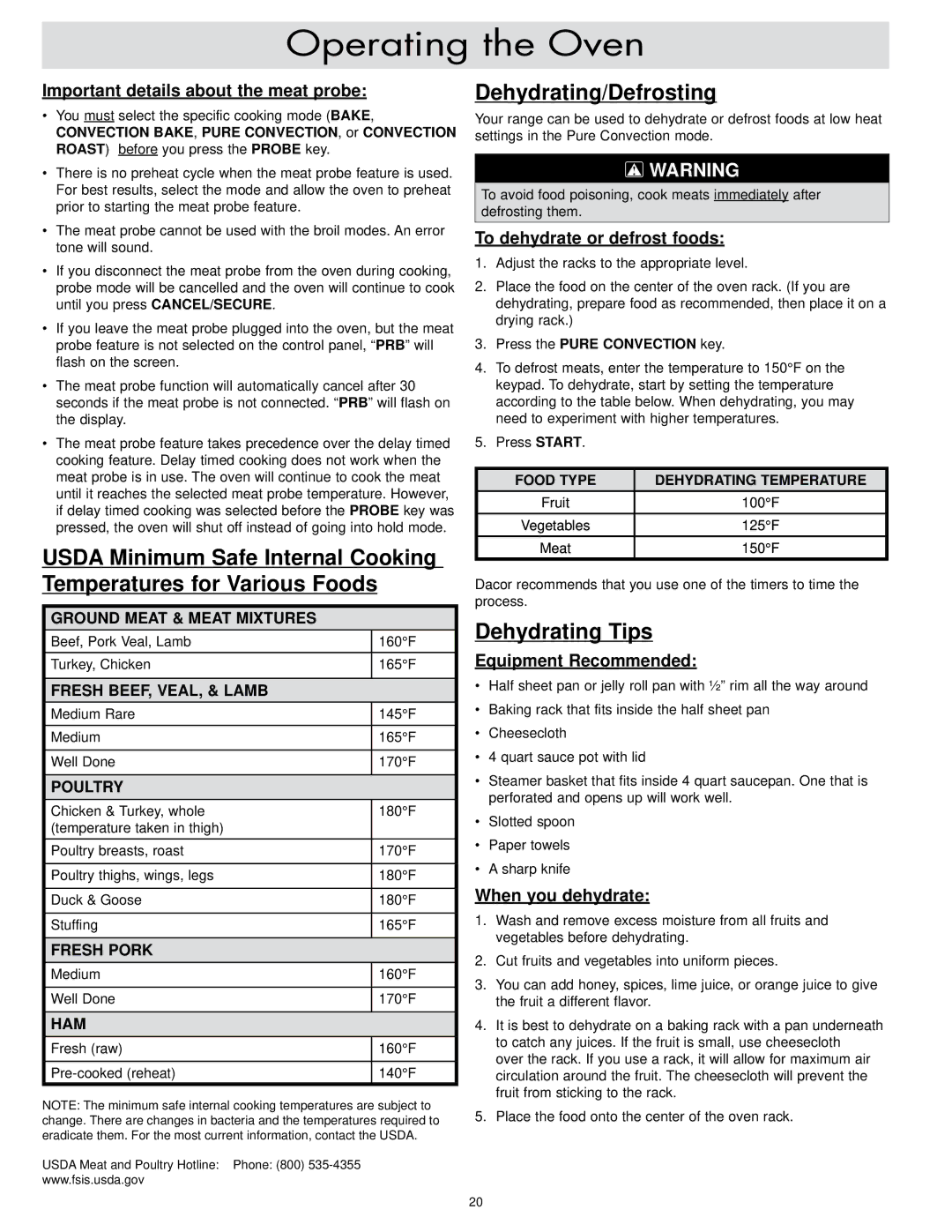
Operating the Oven
Important details about the meat probe:
•You must select the specific cooking mode (BAKE, CONVECTION BAKE, PURE CONVECTION, or CONVECTION ROAST) before you press the PROBE key.
•There is no preheat cycle when the meat probe feature is used. For best results, select the mode and allow the oven to preheat prior to starting the meat probe feature.
•The meat probe cannot be used with the broil modes. An error tone will sound.
•If you disconnect the meat probe from the oven during cooking, probe mode will be cancelled and the oven will continue to cook until you press CANCEL/SECURE.
•If you leave the meat probe plugged into the oven, but the meat probe feature is not selected on the control panel, “PRB” will flash on the screen.
•The meat probe function will automatically cancel after 30 seconds if the meat probe is not connected. “PRB” will flash on the display.
•The meat probe feature takes precedence over the delay timed cooking feature. Delay timed cooking does not work when the meat probe is in use. The oven will continue to cook the meat until it reaches the selected meat probe temperature. However, if delay timed cooking was selected before the PROBE key was pressed, the oven will shut off instead of going into hold mode.
USDA Minimum Safe Internal Cooking Temperatures for Various Foods
ground meat & meat mixtures
Beef, Pork Veal, Lamb | 160°F |
Turkey, Chicken | 165°F |
|
|
Fresh beef, veal, & lamb
Medium Rare | 145°F |
Medium | 165°F |
|
|
Well Done | 170°F |
|
|
POULTRY |
|
Chicken & Turkey, whole | 180°F |
(temperature taken in thigh) |
|
Poultry breasts, roast | 170°F |
|
|
Poultry thighs, wings, legs | 180°F |
|
|
Duck & Goose | 180°F |
|
|
Stuffing | 165°F |
|
|
FRESH PORK |
|
Medium | 160°F |
|
|
Well Done | 170°F |
|
|
HAM |
|
Fresh (raw) | 160°F |
|
|
140°F |
NOTE: The minimum safe internal cooking temperatures are subject to change. There are changes in bacteria and the temperatures required to eradicate them. For the most current information, contact the USDA.
USDA Meat and Poultry Hotline: Phone: (800)
Dehydrating/Defrosting
Your range can be used to dehydrate or defrost foods at low heat settings in the Pure Convection mode.
![]() warning
warning
To avoid food poisoning, cook meats immediately after defrosting them.
To dehydrate or defrost foods:
1.Adjust the racks to the appropriate level.
2.Place the food on the center of the oven rack. (If you are dehydrating, prepare food as recommended, then place it on a drying rack.)
3.Press the PURE CONVECTION key.
4.To defrost meats, enter the temperature to 150°F on the keypad. To dehydrate, start by setting the temperature according to the table below. When dehydrating, you may need to experiment with higher temperatures.
5.Press START.
FOOD TYPE | DEHYDRATING TEMPERATURE |
Fruit | 100°F |
Vegetables | 125°F |
Meat | 150°F |
Dacor recommends that you use one of the timers to time the process.
Dehydrating Tips
Equipment Recommended:
•Half sheet pan or jelly roll pan with ½” rim all the way around
•Baking rack that fits inside the half sheet pan
•Cheesecloth
•4 quart sauce pot with lid
•Steamer basket that fits inside 4 quart saucepan. One that is perforated and opens up will work well.
•Slotted spoon
•Paper towels
•A sharp knife
When you dehydrate:
1.Wash and remove excess moisture from all fruits and vegetables before dehydrating.
2.Cut fruits and vegetables into uniform pieces.
3.You can add honey, spices, lime juice, or orange juice to give the fruit a different flavor.
4.It is best to dehydrate on a baking rack with a pan underneath to catch any juices. If the fruit is small, use cheesecloth over the rack. If you use a rack, it will allow for maximum air circulation around the fruit. The cheesecloth will prevent the fruit from sticking to the rack.
5.Place the food onto the center of the oven rack.
20
